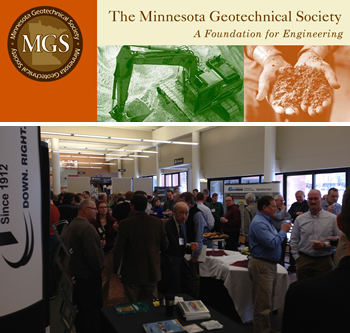 The University of Minnesota held its 61st Annual Geotechnical Engineering Conference on Friday, February 22 at the conference center on the St. Paul campus. Sponsored by the U of M Department of Civil Engineering, the Minnesota Geotechnical Society (MGS), and the Geo-Institute of ASCE, this annual gathering continues to impress. This year’s event focused loosely on instrumentation, data interpretation, and the impacts of geotechnical activities on the environment and structures (such as building overlying tunneling zones). These guiding ideas helped provide significant perspective on the changing practice of engineering.
The University of Minnesota held its 61st Annual Geotechnical Engineering Conference on Friday, February 22 at the conference center on the St. Paul campus. Sponsored by the U of M Department of Civil Engineering, the Minnesota Geotechnical Society (MGS), and the Geo-Institute of ASCE, this annual gathering continues to impress. This year’s event focused loosely on instrumentation, data interpretation, and the impacts of geotechnical activities on the environment and structures (such as building overlying tunneling zones). These guiding ideas helped provide significant perspective on the changing practice of engineering.
This is the second Minnesota Geotechnical Engineering Conference that I have attended, and it is one I intend to return to. The discussions are thoughtful and progressive, and the community of local, regional and invited speaker engineers is an open and encouraging one.
Steve Gale (Gale-Tec), whose name is well-known in the geosynthetics field, served as an excellent chair for the event and, with the help of co-chair Lee Peterson and leadership from the U of M’s Kersten Professor of Civil Engineering Joseph Labuz, ensured a broad and practical geotechnical focus.
This year’s conference enjoyed more than 230 participants and 14 exhibitors, which was a fantastic turnout considering the weather. Winter storms made travel difficult and even prevented the attendance of one of the main speakers, Brett Odgers of TenCate (who was stranded in a snowed-in Kansas City).
Some of the speakers and topics of direct interest for the geosynthetic side of the geotechnical field included:
- Jennifer Nicks (FHWA), “Frictional connecting testing of geosynthetics and implications on design.” Nicks discussed AASHTO’s geosynthetic reinforced soil (GRS) integrated bridge system (IBS) design and construction approach and how LRFD criteria require frictional connection testing. With connection strength testing data from the renowned Turner Fairbank Highway Research Center and offering comparison to large-scale direct shear testing, Nicks provided comfortable insight into one of the fastest growing areas of small bridge construction.
- Tien H. Wu (The Ohio State University), “The observational method: case history and models.” This paper describes the design and construction of an embankment over a soft sludge deposit. Geotextiles and prefabricated vertical drains were part of the work.
- Rudolph Bonaparte (Geosyntec Consultants Inc.), “The Business of Geotechnical and Geoenvironmental Engineering.” Dr. Bonaparte presented a shortened version of his Geo-Congress 2012 lecture. Loaded with historical developments in geotechnical engineering firms, the talk highlighted how geoengineering was once a hallmark of major engineering companies; but today the practice of engineering has become far more inter-disciplinary and geoengineering has become a smaller, in-house expertise. Geoengineering companies dedicated to geoengineering increasingly cap-out around $50 million in revenue before either plateauing or being acquired by or merging with a more multi-disciplined firm.
- Nate Lichty (Gale-Tec), “Bridge approach embankment slope distress: analysis, monitoring, design & remediation – a cast study.” When a highway overpass was being constructed over a railway, some unexpected slope distress and cracking appeared. An unknown layer of peat was discovered. To resolve the problem, a lightweight fill in a geotextile wrap was installed. This presentation generated plenty of discussion, as problems with shredded tire lightweight fill in the 1980s and into the 1990s led many to abandon thoughts of utilizing this approach. For this project, however, it offered a significantly lower cost solution. The proper use of the geotextile wrap has controlled the moisture and temperature concerns previously associated with the use of this fill.
- D.J. Mattison (MnDOT), “Embankment performance monitoring for construction control and design validation.” To more economically construct a multi-span bridge on a rural highway, an alternate plan involving excavation, soil replacement, and soil preload and surcharge was used. Three layers of geosynthetic reinforcement were installed to reduce the amount of poor soils that needed to be excavated. Roughly $1 million was saved by using this construction method.
As noted above, we were unfortunately denied an in-person presentation of Brett Odgers’ paper on “Use of Mirafi H2Ri wicking geosynthetic to help prevent frost boils on the Dalton Highway, Alaska.” But his paper is in the event proceedings and shows new promise in more economically and effectively constructing roads in difficult, cold weather soils.
In total, there were 12 presentations/papers, with the first half of the event before the entire group and the second half divided into two tracks.
I would like to thank the students of the U of M Department of Civil Engineering and the many Minnesota Geotechnical Society volunteers for helping the event run smoothly. Thanks too to Tim Bendell (TenCate), Jeff Christiensen (Ground Improvement Engineering), John Allen (TRI Environmental), the Keystone Retaining Walls team, and Steve Gale (Gale-Tec) for sharing a little extra time and geotechnical engineering discussion. Your insights are appreciated.
To be sure, I look forward to next year’s gathering. In the meantime, I will take advantage of the monthly Minnesota Geotechnical Society meetings. For more information on the conference and the MGS’s activities, visit the society website.
Chris Kelsey is the editor of Geosynthetica. He has worked in the geosynthetics industry for 12+ years.











